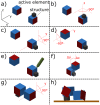Morphological Evolution of Physical Robots through Model-Free Phenotype Development
- PMID: 26091255
- PMCID: PMC4474803
- DOI: 10.1371/journal.pone.0128444
Morphological Evolution of Physical Robots through Model-Free Phenotype Development
Abstract
Artificial evolution of physical systems is a stochastic optimization method in which physical machines are iteratively adapted to a target function. The key for a meaningful design optimization is the capability to build variations of physical machines through the course of the evolutionary process. The optimization in turn no longer relies on complex physics models that are prone to the reality gap, a mismatch between simulated and real-world behavior. We report model-free development and evaluation of phenotypes in the artificial evolution of physical systems, in which a mother robot autonomously designs and assembles locomotion agents. The locomotion agents are automatically placed in the testing environment and their locomotion behavior is analyzed in the real world. This feedback is used for the design of the next iteration. Through experiments with a total of 500 autonomously built locomotion agents, this article shows diversification of morphology and behavior of physical robots for the improvement of functionality with limited resources.
Conflict of interest statement
Figures





References
-
- Pfeifer R, Lungarella M, Iida F (2007) Self-organization, embodiment, and biologically inspired robotics. Science 318: 1088–1093. - PubMed
-
- Gross R, Dorigo M (2008) Self-assembly at the macroscopic scale. Proc IEEE 96: 1490–1508.
-
- Nolfi S, Floreano D (2000) Evolutionary robotics: The biology, intelligence, and technology of self-organizing machines. MIT Press, Cambridge, MA.
Publication types
MeSH terms
LinkOut - more resources
Full Text Sources
Other Literature Sources
Miscellaneous

